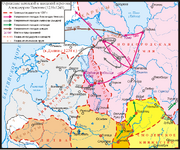The Principality of Pskov (Russian: Псковское княжество, Pskovskoye knyazhestvo) or Lordship of Pskov (государство Псковское) was a medieval state that grew out of the Rus' Khaganate in the late 9th century. The city of Pskov was founded by the Rus', then expanded into a duchy or principality. It was a vassal state of various Rus' states between the 1230s and 1348, when the Treaty of Bolotovo recognized the independence of Pskov (known in historiography henceforth as the Feudal Republic of Pskov); it then came under protection of the Grand Duchy of Moscow.[1]
Geography[]
Pskov is situated on the southern shore of the Lake Peipus, to the east of Livonia, and to the west of Novgorod. In the 13th century, the Principality of Pskov was a narrow strip of land along the eastern Narva River and Peipus, bordered to the south by the Velikaya River basin.[2] The division between Livonia and Pskov was made up by an area of water bodies and poorly settled areas.[2]
History[]
Early history[]
The town of Pskov was founded in the late 9th century by the Rus'. Olga of Kiev, the wife of Igor of Kiev, was born in Pskov. In 1065–67, Vseslav Bryachislavich of Polotsk attacked Pskov and Novgorod, then was captured by Izyaslav I of Kiev and his two brothers and imprisoned in Kiev.[3]
13th century[]

Military operations of Alexander Nevsky (1239–42), Pskov seen in dark pink (1237 borders). (Russian)
In 1218, the princes of Novgorod and Pskov attacked Estonia and Latvia, while the Lithuanians had attacked Pskov in the meantime.[4] A conflict ensued in the following years between Pskov and Letgallia.[4] Pskov invaded Livonia in 1221.[4]
The Novgorod Chronicle mentions the campaign Yaroslav Vsevolodovich of Novgorod in 1228; Yaroslav led his army against Pskov, upon which the inhabitants sealed the city and refused to let Yaroslav in.[5] There were rumours that Yaroslav now wanted to imprison Pskov's most notable men, but Yaroslav declared that he had good intentions, wanting to deliver gifts, and now assembled an army and to attack Riga.[5] Now, Pskov entered a military alliance with Riga.[5] The Novgorod nobility believed that Yaroslav had merely used the pretext of attacking Riga to conquer Pskov.[5] Yaroslav now asked Pskov to take part in the attack, but Pskov refused.[5]
Between 1236 and 1242, the Kievan Rus', except Novgorod, Pskov, Smolensk and Polotsk, was conquered by the Golden Horde.[6] The Grand Duchy of Lithuania quickly expanded their influence on the western Rus' lands in the second half of the 13th century, these Russian principalities preserving a kind of autonomy, still under the direct rule of the various branches of the Rurikids.[6]
The Teutonic knights captured a fort southwest of Pskov, then occupied the city in 1240 and established rule to the west of Novgorod.[7] After appeals from Novgorod, Grand Prince Yaroslav sent two brothers, Alexander and Andrey, who expelled the knights and halted their eastern advance.[8]
14th century[]
In 1316, Pskov troops took part in a Novgorod campaign against Tver.[9]
In the 1320s, the coalitions of the Teutonic knights and Novgorod, on one side, and of Lithuania, Pskov and their Livonian allies, on the other side, faced each other in the region.[10] In 1322–23 Pskov campaigned as a Lithuanian dependency, probably first in the Lithuanian attack on Dorpat (March 1322),[10] then in the Grodno raid into Danish Estonia (1323).[11] In response, in May 1323, knight Kesselhuth launched a 18-day siege of Pskov, while Pskov's request to Novgorod and Yuri Danilovich for aid were refused.[11] The siege was ended after an army dispatch from Lithuania, after which peace was agreed.[11]
Alexander Mikhailovich of Vladimir was forced to flee after a joint Muscovite–Tatar invasion in 1327, and found refuge in Pskov.[12] He was excommunicated by the city metropolitan, but returned in 1331, ruling the city until 1337.[12]
Rulers[]
References[]
- ^ Martin 2007, p. 343.
- ^ a b Selart 2015, p. 17.
- ^ Martin 2007, p. 31.
- ^ a b c Selart 2015, p. 113.
- ^ a b c d e Selart 2015, p. 127.
- ^ a b Selart 2015, p. 18.
- ^ Martin 2007, p. 180.
- ^ Martin 2007, p. 181.
- ^ Selart 2015, p. 273.
- ^ a b Selart 2015, p. 274.
- ^ a b c Selart 2015, p. 275.
- ^ a b Martin 2007, p. 196.
Sources[]
- Michael Jones (1995). The New Cambridge Medieval History: Volume 6, C.1300-c.1415. Cambridge University Press. pp. 765–. ISBN 978-0-521-36290-0. https://books.google.com/books?id=LOS1c0w91AcC&pg=PA765.
- Martin, Janet (2007). Medieval Russia, 980-1584. Cambridge University Press. ISBN 978-0-521-85916-5. https://books.google.com/books?id=9JHwVtL7qDcC.
- Selart, Anti (2015). Livonia, Rus’ and the Baltic Crusades in the Thirteenth Century. BRILL. ISBN 978-90-04-28475-3. https://books.google.com/books?id=dHu9BwAAQBAJ.
- Savignac, David (trans). The Pskov 3rd Chronicle. https://www.academia.edu/28622167/The_Pskov_3rd_Chronicle.